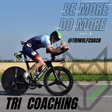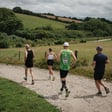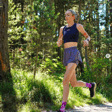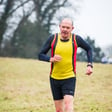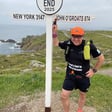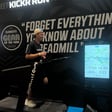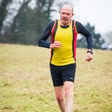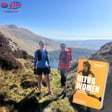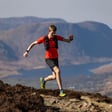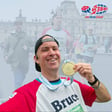Become a Creator today!Start creating today - Share your story with the world!
Start for free
00:00:00
00:00:01

Stuart Gordon | Sports Therapist | All About Balance
In episode 50 we welcome back Stuart, Sports Therapist of over 30 years, from All About Balance UK.
Stuart is the UK Distributor of Barefoot Science insoles, an in-shoe training system that strengthens your feet and improves your balance the instant you fit them into your shoes.
In this episode we cover injury advice from questions taken from the #UKRunChat community.
To listen to our previous podcasts with Stuart click the below:
With Dr Peter Gorman
With Dr Susie Cooper
You can connect with Stuart on:
Transcript
Introduction and Guest Introduction
00:00:00
Speaker
Welcome to episode 50 of the UK sports chat podcast. I'm Joe Williams and in today's episode I speak with Stuart. Stuart is a sports therapist of over 30 years. He's from All About Balance UK and it's the third in our series of podcasts with Stuart.
00:00:16
Speaker
Stuart is the UK distributor of Barefoot Science Insoles, an in-shoe training system that strengthens your feet and improves your balance from the instant you fit them into your shoes.
Injury Advice and Listener Feedback Request
00:00:26
Speaker
In this episode, we cover injury advice and questions taken from the UK Run Chat community. As usual, please send us your feedback on our social channels or you can get in touch on info at ukrunchat.co.uk. Have a great week and see you on the next episode.
Event Participation and Engagement
00:00:44
Speaker
Welcome, Stuart.
00:00:47
Speaker
Thank you. Nice to chat again, Joe. How are you? I'm very well, thanks, yes. I'm actually having a few days off and so I'm refreshed. Good. Very nice. Always good to have a few days off. Yeah.
00:01:04
Speaker
So what have you been up to since we last spoke? I think our last podcast was the end of August, the start of September. I think you were heading off to Runfest Run and the morning expo. I had the two events. Runfest run down at Lava Stoke Park, which was interesting. Obviously, one of the first events back after lockdown.
00:01:27
Speaker
Yes. You know, the organizers worked pretty hard to try and get the numbers up and they combined it, in fact, with Carfest, because obviously both shows are Chris Evans babies.
Personal Interactions and Event Highlights
00:01:40
Speaker
And it kind of wasn't as well attended as I hoped it would be. And I think as the other exhibitors felt the same. But there's some good quality people came along to the stands and we had some great engagement. Sold quite a few pairs of insoles, which was great.
00:01:56
Speaker
Yeah. And the big bonus, apart from that, of course, was meeting Colin Jackson and Jamie Bullshad. I remember seeing your photo on Twitter, actually. I have to say, you know, meeting both of those guys, Colin in particular, you know, as a sports fan, and I was a sprinter more than a long distance runner, watching Colin Jackson competing over the years was like poetry in motion. He was wonderful, wasn't he? Yeah, I did point out to him that
00:02:25
Speaker
barefoot science insults may have helped him achieve great things. He didn't seem to appreciate that. He didn't do bad, did he? No, exactly. God, do me. But yeah, so that was great. And then we went on to the National Running Show South at Farnborough, Hampshire. And that was, again, you know, the organizers worked really, really hard at getting the numbers up. You know, they
00:02:54
Speaker
openly admitted that the numbers were lower than they would have hoped for, but obviously under the circumstances were pretty good. And we actually had some great engagement. I spoke on the running skills stage, both mornings, about contact time and running efficiency and the importance of balance in that function and had some really, really good engagement and a load of fun as well. I got people up on the stage, both
00:03:23
Speaker
both mornings doing
Proprioception and Injury Prevention
00:03:24
Speaker
my little one legged balance tests and marching on the spot. And of course, as you know, because I've done these on you, both involve closing your eyes. And I have to say, there was a moment of almost classic comedy where I've got this guy and a girl marching on the spot with their eyes closed. And I turned around to the audience and I was saying how, you know, we're doing this
00:03:51
Speaker
how brave it is for these people to do this without the aid of a safety net. And I turned around and saw the guy flying forward straight towards the front of the stage, because he completely lost any awareness of where he was in space. And he was literally sort of marching forwards quite quickly. He had to leap across and stop him before he plummeted to injury, which I don't think would have gone down very well. But it was a very graphic example of how when you take the eyes out of the equation,
00:04:20
Speaker
you become more reliant or totally reliant on the information coming out from the soles of your feet through your shoes. Yes. Which is the whole essence of what our insoles are about, which is providing proprioceptive stimulus from within the shoe to tell your body what's going on around you. And whilst we don't run with our eyes closed, when we run, we're not using our eyes to help us balance. So we're using them to look ahead for potential hazards or obstacles, whether it's trail running with tree roots and
00:04:50
Speaker
Hot holes in the roads over there, pedestrians and other runners and whatever it might be. Yeah. So it was it's a very, very useful test as a sort of an example of how we become hugely reliant on our eyes to help us. Yeah. And how inefficient the proprioceptive system from the sole of our feet can become. And that and the one legged balance test sort
Barefoot Science Insoles and Demonstrations
00:05:14
Speaker
of demonstrate the same thing. So that was that was good fun. And
00:05:17
Speaker
I saw loads and loads of people on the stands and did those tests on my little stepping gate test on the stand about 45 times, I think. And of those 45 times, what was really interesting actually for us was that pretty much everyone that came on the stand had a problem, an injury of some sort, whether it was Achilles tendonitis or shin splints or plantar fasciitis or hip pain.
00:05:47
Speaker
or a knee, runners knee obviously is a classic, you know, there was almost, almost without exception, people had these injuries and they'd been niggling injuries that had been going on for a while or some people have been unable to run, they'd have to stop running because of them. And what we do, when I then put them through my little ground force reaction test, which is when you see what happens to the foot as it lands on the floor and then what happens to the shin and the knee and the thigh and the hip.
00:06:15
Speaker
You see these unusual patterns that explain why the injuries are occurring. And then what I do in that demonstration is I then pop the Bethel Science Insole underneath the foot and retest. And what we see in every single case, and I've done thousands of these now in my clinic and on this stand, is that the body reverts to correct function. The foot starts to manage its landing better as it goes into pronation and then it
00:06:44
Speaker
When you step through, the foot goes nicely into supination and the shin and the thigh and the hip and the knee do the things that the body's designed for them to do within reasons. There's no two people who are exactly the same, but there are certain rules that we're looking for of movement patterns.
Importance of Proprioceptive Feedback
00:07:01
Speaker
And we see that changing. We see it changing for the positive every time. And of the 43 tests I did, I think 40 people bought insults. So that was a fantastic example of the benefit that that little test
00:07:14
Speaker
can show. Yes. That was really good fun. Really good fun. Yeah. So just to go back to your gentleman on the stage, you started marching forward. So his instruction was to march on the spot. Yes. And because he's got his eyes closed and his proprioception isn't telling him to stay on the spot. He kind of loses where he is. Is that right? Exactly. So the proprioceptive nerve system is a system that's embedded in our soft tissues right throughout the body from head to toe.
00:07:44
Speaker
And when we move, our tissues move and that movement of tissue sort of agitates the nerves that are embedded in them, the proprioceptive sensory nerves that are embedded in them. So it tells us where we are in space relative to things around us. So if you're having one of those days where you're tripping over things or bumping into things or dropping things, that system's not working very well.
00:08:11
Speaker
It also helps manage our balance. It's one of the three parts of our body system that manage balance along with our eyes and a bit of our inner ear called the vestibular. And the point again for when we're running is we can't use our eyes and our ears are working really hard as with heads moving around and bobbing
Injury Treatment and RICE Principle
00:08:31
Speaker
along and looking around for things. So our ears are working hard in lots of different ways. So we've become significantly more reliant on
00:08:39
Speaker
the landing of our feet on the ground to read the ground conditions and feed that information back. Now that's the same whether you're marching on the spot or whether you're standing on one leg or whether you're running or walking. We need the feet to read the ground to tell us where we are in space and to tell us how to balance and manage our body. And the third thing the proprioceptive system does is control something called the stretch reflex. Stretch reflexes are
00:09:06
Speaker
a gift to injury avoidance. And as our foot hits the floor, the bottom of the foot should stretch and manage the foot's movement into pronation. Similarly, when our glutes engage, they push the hip forward, which stretches the hip flexor, but we don't want that to overstretch. If we're throwing a stick for the dog, we don't want our arm to go flying out of the socket with a stick. We want the brakes to be put on to manage that stretch.
00:09:34
Speaker
And that's what the proprioceptive system does. It controls that through the stretch reflex to stop us getting injured and say, okay, put the brakes on. So it's hugely important for those different areas. And the marching on the spot test, eyes open, you start off, you stay on the spot because you can see things, you know where you are. You take the eyes out of the equation and it reveals how effective the proprioceptive system is. And in Matt Chap's case, it was pretty disastrous. Actually, I've put out,
00:10:03
Speaker
I'm hoping he might even be listening. His name is Simon. And if he does listen to this podcast, I've put a post out on the National Running Show Facebook and Instagram and put it out on our Facebook channel. It's to say, Simon, give me a shout. I want to give him a pair of insoles as a thank you for being such a fantastic guinea pig and to help him because he had the most unusual problems with coordination. So his feet and his legs and his arms were doing completely different things.
00:10:33
Speaker
instead of having that nice sort of opposite arm, opposite leg movement that we should have when we walk and run. His arms were doing one thing and his legs were doing something completely different. So, you know, his system, his brain needs some better information coming to it to help manage his body better. And so Simon, if you're out there,
00:10:53
Speaker
Yeah, come on Simon. I'm probably going to get 50 calls from different Simon. It's very interesting how this all starts at the feet. I know we said in the intro we were going to do some more generic stuff, but this is really interesting. It's interesting how fixing that starts at the feet.
00:11:21
Speaker
Yeah, yeah, it does. And I suppose the point, again, the way to describe it is that when we're walking or running or playing any sport that's an upright sport that requires us to move on our feet, they're the only thing actually in contact with a firm surface with the ground through the sole of the shoe that can give us that spatial awareness, that information all of the time. Our eyes are working hard to follow a ball if we're playing a ball sport.
00:11:51
Speaker
As I said, we're running, they're looking ahead, scanning around in a race and looking at competitors, looking at the ground ahead, looking at, you know, whatever's going on around them. Um, and the ears have been bombarded with information. If you're playing a, you know, a game of this rugby or hockey or whatever it might be netball, there's lots of noise going along. So, so the brain's been bombarded with all of this information from our senses and it's, it's the job of the feet to give as much information as possible to the brain about how to manage movement safely and efficiently.
00:12:21
Speaker
that's through that proprioceptive nerve system. So yeah, so it starts with the feet when we're moving. Interesting stuff, very interesting.
00:12:29
Speaker
Let's move into some of the questions we've had from community members on Twitter. So we started a bit of a thread on that. We said we'd do this, didn't we? And then I've got some other questions on some of this stuff that we spoke about on the last podcast as well. So first up, but yeah, we started a thread last night. Questions for a physio sports therapist. What would you ask? First one was, at what stage would you see a physio? I've had a pain niggle for X amount of time. Do I wait and rest it for a bit or do I see someone straight away?
00:13:01
Speaker
I would say, well, the first thing that people should do straight away is get some ice on something. Follow the basic rules of the rice principle, which is rest, ice, compression, and elevation. So if you've strained something, or pulled something, or torn something, or even whacked something on, you know, whacked a knee on something as you've been out, the best thing you can do very quickly, as soon as possible, is to get ice on it. And they're swelling, elevate it, and rest it.
00:13:26
Speaker
The general rule is that you would do that for the first 48 hours, you would stick with ice and then you can move gradually towards heat as things improve. How long would you ice it for and how often in that 48 hours? As a general rule, 10 to 15 minutes of ice, and if you can do that in an ideal world, and I know that we don't live in an ideal world, but if you could do that every two to three or three to four hours, that's fantastic. If you can do it,
00:13:54
Speaker
more regularly than once a day, it's better than none. It's simply what you can fit in. I mean, I say to people in clinic, stick an ice pack on at breakfast, stick an ice pack on at dinner time, stick one on just before you go to bed. And if there's a chance during your working day, at the moment, obviously lots more people working at home, it's a bit easier. But to get that ice on there 10 to 15 minutes, if it's a hamstring or a big quad muscle or hamstring or glute that you think you're taught, you might need to keep on slightly longer because they've
00:14:23
Speaker
Obviously you've got to get the ice down. If you leave ice on for too long, what happens? So what happens with ice is it literally numbs the area, it knocks the nerves out so they can't send or receive signals. So consequently then the muscles that have gone into spasm have to let go because they've not been given an instruction to do anything other than that. So hopefully they'll relax. And as I say, you numb the nerves and you also constrict the blood vessels so you can't leak blood or fluids into the surrounding tissues to cause swelling.
00:14:51
Speaker
So that's the initial purpose of I should get it on there. But at some point you need to reintroduce heat to bring fresh blood to the area as your tissues heal. They've been with them all the nutrients to help with the healing process. So yeah.
00:15:06
Speaker
Okay. There's some big old bags of peas needed for quad muscles. You can get all of these. There's loads of different ice packs that you can buy now, flexible ones that just keep in the freezer. And then if you need them as a heat pack, you just stick them in the microwave or whatever. What I suggested to my clients over the years is if they go into an event, there may not be the facility to keep an ice pack.
00:15:34
Speaker
cold enough, but you can get these disposable single use ones where it's basically some sort of plastic bag with two different types of material in there with the inner bag. And when you sort of break that inner bag by hitting or twisting the whole thing, it releases the two chemicals and they react with each other to produce cold. So my suggestion to all athletes, all runners and sports people is have a couple of those in your kit bag so that if you do get an injury,
00:16:03
Speaker
you can get that ice on there as quickly as possible. And that can make a huge difference between a quick return and, you know, a longer return. I remember years and years ago, there was some research done showing that if you got, if you sprained an ankle, if you got an ice pack on within, you know, within minutes, it could be the difference between, you know, a couple of weeks and six weeks out. It can be that important now. So that's why we see, you know, if we watch the football on the telly or we see different sports,
00:16:33
Speaker
the guy who's gone off injured, or the girl that's gone off injured, will be then sitting at pitchside and they're dug out with a nice pack strapped to them. Straight away, yeah. Yeah, absolutely. So the compression and elevation bit then. Yeah.
00:16:48
Speaker
talk us through compression on a sprain or something like that. I have a memory, I would have been about 12 or 13 years old and I can remember doing something to my ankle, playing football and getting home and my mum banned the gym with my foot up. And I woke up in the night and just tried to get up and I couldn't walk. I'm pretty sure that's because the compression was too tight and my foot was blown. Did your toes start falling off?
Consulting Physios and Personal Injury Stories
00:17:17
Speaker
compression and elevate and and you know how high is your foot elevators above your hip is it you know is it just off the floor what we're trying to do with the elevation thing is to assist the the flow of fluids back towards the the heart so when you when you injure something or tear something and it leaks fluids we need that swelling to be shifted
00:17:42
Speaker
back up the body, if you like. So if it's in the lower part of the body, we've got to get it tracked up. Now that's going through something called the lymphatic drainage system. And the lymphatic drainage system relies on movement, um, to help create a sort of a pumping action. Well, obviously if you're injured, you're not going to be moving so much. So then what we can do is elevate it because gravity will help it. It's not been pumped, you know, blood coming from the heart and through the arteries has been pumped by the heart.
00:18:08
Speaker
The lymph system relies on the muscles contracting and relaxing around it to create a pumping action. So if you're going to be keeping fairly still with after an injury, elevating it will provide the assistance of gravity. So if it's an ankle injury or knee injury, you definitely want to get it above the level of the hip if you can. Basically, this is a bit of a simplification, but the bending bits of the body is where you have these lymph glands or filter stations.
00:18:37
Speaker
So we want to get the swelling tracking its way back through the lymphatic drainage system to those filter stations where some of it will get sweated out, some of it will get sent off to the kidneys for disposal, and some will get sent on to the next lymph station, the filter station, and so on, eventually going through and back into the heart and the lungs for re-circular or re-oxygenation and re-circulation. So the elevation will help that, you know, and you can maybe, if you haven't got a blood pressure problem, for instance, you can stick a few
00:19:06
Speaker
books or cushions under the foot end of the bed at night, just so while you're asleep, it's at least flowing back in the direction of the heart. Sit on the sofa with your leg up on a stall in front of you while you watch your telly and things like that. Compression, you can often, these days actually, there's some great stuff out there for compression and ice at the same time. So you have systems where
00:19:30
Speaker
you fill a wrapping with freezing cold water, which is attached to a bucket with freezing cold water. And when you raise the bucket above the height of the wrapping, all the cold water flows in, provides the cold, but also expands that wrapping to compress on the knee or the ankle or whatever it might be. And then you leave it like that for 10 minutes or so, and then you pop the bucket down below the level of the knee, so all the cold water flows back out, so it releases the compression. And then a bit later on, you lift it back up again,
00:19:59
Speaker
and you recreate the cold and the compression. So you're creating that pumping action of the compression and then the release of compression whilst combining it with the cold effect of the ice. They're brilliant, those sorts of things. There's lots of variations of that out there from companies on the internet. You just track those things down.
00:20:21
Speaker
Um, yeah, so that's the, there's some great stuff out there, which, which we can help us. But as I say that the bit about getting the ice on as quickly as possible, I think is, is really, really important and having those disposable ice packs, uh, can make a huge difference. Yeah. You know, immediately after the, you know, you come out of the race injured or whatever in the car sitting on it or wrapping it around your knee with a bit of, um, bit of bandaging or, you know, an old towel or something, just to keep the compression on, keep the ice pack in place.
00:20:48
Speaker
make a huge difference for you recovering quicker to get back to doing what we all want to do and get out and compete and run and whatever it is. Yeah. So yeah. Okay. In terms of when to see a physio go back to the original question. Sorry, I digress. Yeah, it's good. It's good. If you do the ice and such like, and the swelling hasn't gone and the pain's still there,
00:21:10
Speaker
don't leave it any longer, you know, get an appointment to see a sports physio or a sports therapist. And, you know, if it's really bad, you know, at the event, and you've heard a nasty tear or a crack, even go to, you know, go to A&E and get it checked out, sharpish, because I've had, astonishingly, people come to me with ruptured tochilles tendons. And they've been walking around on them for two or three weeks after the event. Well, yeah, I heard a sort of like a gunshot type noise.
00:21:40
Speaker
But yeah, it's been okay. I've been walking into work every day. And I tested this by, and there's a very simple test for seeing whether the Achilles tendon is still attached. And his wasn't. So, yeah, so it was astonishing. And of course, by that time you start, you know, they leave it too long, the tissues die back and it makes the healing process a bit of a nightmare. Do I have a slight confession here, Stuart?
00:22:08
Speaker
I did exactly that when I ruptured my Achilles. I thought it was my calf that had popped. And I did exactly as you described. I walked around for probably four weeks and I went to A&E eventually and full rupture of my Achilles. And when they operated, they found it up the top of my calf. It had rattled all the way up.
00:22:37
Speaker
yeah i mean that's why you did it was there any swelling or bruising that came out it was 2010 i can't remember exactly but i heard it i can remember the definite like it was like a gunshot it was like 20 and i thought oh no me calf's gone it's really interesting because to say there's a couple of people i've had this with and in both cases like yours it was this complete rupture yeah
00:23:05
Speaker
And they didn't get huge amounts of swelling or bruising coming out. And I wonder whether if it's that clean, complete tear through, you don't, maybe don't get it. I don't know. I'm sort of just hypothesizing with this one, but it'd be interesting to see whether this has happened to other people as well, because if somebody's had a partial tear, um, I've seen, you know, the swelling can be immense and the bruising can come out. You can see all the, all the hematoma that's formed deep bruising there. But.
00:23:31
Speaker
for this few people I've seen and adding you to it now, who have completely ruptured it and then carried on regardless. It's almost like it's bypassed, that's the swelling and bruising stage quite strange.
00:23:46
Speaker
I fully recovered from it. I remember it being in the boot for a long time and on the crutches, so perhaps your point about things taking longer was certainly true with that because I can compare it to ACL injuries in the knee and things like that. By that point, I'd had two or three ACL injuries.
00:24:07
Speaker
I was much more disciplined and actually listened to the professional's advice, which a lot of people don't do. They don't stick to the exercises and be disciplined with it. And I made a full recovery with that particular injury.
Addressing Persistent Hamstring Issues
00:24:23
Speaker
Very interesting. So the next question was, despite warming up properly in copious stretching, I still have one hamstring that gives me grief. What can I do? And obviously, this is all general advice that Stuart's given now. We know that we can't be specific to people with individual ailments and injuries. Yeah. I mean, if in a situation like that, if you tried stretching it out, you tried loosening it off, presumably tried a bit of strengthening work as well, and if it's still playing up, then there's something else going on.
00:24:52
Speaker
Now, yeah, obviously, I could throw a number of different things at this, it could be coming from the back downwards. So if there's a problem at the bottom of your back in the lumbar spine, it can be pinching on a sciatic nerve term. And usually it's what's the L5 S1, the bottom lumbar vertebra. The nerve coming from there goes straight down through the buttock, down the back of the leg through the hamstring. So if there's an irritation
00:25:18
Speaker
at nerve root level in the buttock, sorry, in the spine, it could be what's causing that hamstring to stay tight. Equally, there's a muscle in the buttock that the sciatic nerve either passes through or just under, called the piriformis, and that can pinch on the nerve and irritate it, which could send a signal down to the hamstring and cause the hamstring to be still tightening up. So those are some options, in which case you've got to go and see somebody to get some treatment and see whether to check the back out, check the piriformis out.
00:25:47
Speaker
could be coming from the foot upwards. And of course, this is where, you know, we major a lot, I treat equally on both ends of it. I always look at both ends of it when people come and see me, to see whether there is something going on with the athletes or the person's feet that could be causing a problem further up the chain that could be reflecting back down again. You know, there's a bit of a chicken and egg thing with all of this stuff. So get it checked out. If it's not loosening off with just a bit of general stretching and light running,
00:26:16
Speaker
then it sounds like it's not going to. There's something else that's causing that, and could be your back, could be the piriformis, could be your feet.
Inner Thigh Cramps and Weak Glutes Discussion
00:26:23
Speaker
Get them all checked out. Go get checked. Yeah. Okay. Next one was, I occasionally get severe cramp in my inner thighs when running long distance. Once started, it just doesn't stop, usually triggered when climbing over something or steps that mean raising my upper leg past hip height. Okay. So inner thigh,
00:26:45
Speaker
can be what are called the adductors, but I'm guessing from the second part of the description about going up steps, it's probably a hip flexor muscle. The hip flexors come off the inside edge of the top of the thigh bone, and they go right through the hip socket and attach onto all of our lumbar spine. It's the big, big muscles, actually three muscles that form the hip flexor group. And it's actually the only muscle that connects the upper body to the lower body through the pelvis.
00:27:16
Speaker
big important muscle for running and walking by any sport really. And it may be that that's where the problem is. It's either a weakness in the hip flex or it's not been stimulated to work correctly. Now, when we look at running, running is a posterior chain movement. We're looking for the power to come from our glutes and our hamstrings to drive us forward. So when the glute fires up to push your hip forward, what it should be doing then is if that happens,
00:27:45
Speaker
The hip goes forward and the hip flexor gets put into a stretch. And then when you push off with your toes, that's the trigger to release that stretch that you put the hip flexor into so that it then recoils to help pull the leg through. And the hamstring is also doing the same thing. It's been stretched as you stride forward and then recoiling as you push off to drive the knee forward. So if the glute isn't firing up, for instance,
00:28:12
Speaker
as efficiently as it should do, because it's not been told to by the neurological system, then you don't get the stretch in the hip flexor. So what you then end up doing is using hip flexor to pull the leg through rather than recoil. And it will get very quickly tired. And then you'll get fed up, you'll get fed up with doing that job and it will go into a spasm to try and protect itself or cramp up.
00:28:34
Speaker
And then going up steps is going to accentuate that and going over, you know, lifting your leg up to go over as a style or something when you walk. Yeah. So it could well be that just, it sounds, definitely sounds like a hip flexor problem. Um, whether it's coming from, um, again, you know, it links to the low back, um, it links to what's happening with the feet and whether the glutes have been given the instruction to fire, to push the hip flexor forward. I do a really simple test when everyone comes to see me, I always test the glutes.
00:29:01
Speaker
and the hamstrings, and I always test the hip flexors to see whether they're strong, whether they're firing up or whether they're just, and often it's not that the muscle's weak, it's just that it's not getting a signal to tell it to work. The analogy I use is rather like a light switch. You know, the foot hitting the ground, and I'm coming back to that again, and creating that proprioceptive stimulus is the light switch. That's the switch going on. And then the wiring going up to the control board,
00:29:30
Speaker
which is our brain and the wires are the nerves, go up to the control board, the control board then sends out an instruction to the muscles to do something which, you know, an electrical circuit with a light bulb lighting up or an appliance switching on. You've got to have the switch on at the bottom. You've got to have the wiring intact going up to the brain. You've got to have the brain functioning well. So someone's got concussion or a neurological disease, sadly, something like Parkinson's or a stroke. Then the control board's being affected.
00:29:55
Speaker
If a nerve's been pinched at nerve root level in the spine or by a muscle like the piriformis, as we were saying earlier, that's going to affect the wiring, so the signal's not going to get through properly. But you've got to make sure the switch is on. And that's where, again, coming back to the way that our insoles function, that's their job, is that they are switching on that proprioceptive system at
00:30:16
Speaker
ground level and floor level with the foot. Yeah it's interesting because one of the last questions that came in was from Kevin Main at Kevmain. He said is it ever anything other than weak glutes? I honestly don't think weak glutes is the right description or weak hip flexor or whatever you'll find and I've had people I've tested them and you know the simple way you put somebody flat on the floor in their front and just ask them to lift their leg up keeping it straight is the glute firing up?
00:30:47
Speaker
Can you keep the leg up in there if I push down against it? Is it the hamstring working hard first or is it the glute working hard first? Quite often it's a sequencing thing because of this sort of a crosswire or situation like that. And you'll find that the hamstring fires up before the glute does. So it feels like you've got a weak glute. Now, when you reorganize things and get the system firing up better, there's nothing wrong with that person's glutes. There are very few runners out there who are going to have weak glutes.
00:31:14
Speaker
But what they may have is bloops that aren't being switched on at the right time or the right part of the sequence of movement. So that's what you have to correct. So it's very rarely weak anything, to be honest. It's just not being switched on. Okay. Let's come back to, as I mentioned in the introduction, this is the third in our series of podcasts. And the last one we had Dr. Peter Gorman on, didn't we?
00:31:44
Speaker
I mean, he's achieved some amazing things. His heart rate monitors, he's produced for Polar and he actually made them, didn't he? And he spoke about, and I've actually got, I have got the clip, which I can play through my phone. I'm hoping that you can all hear it. Well, everyone will be able to hear it. And it actually related back to one of the questions that you asked.
00:32:03
Speaker
during one of the sponsored hours as well. Your question was, which phase of the human gait cycle do you think is most important in injury prevention?
Gait Cycle and Foot Muscle Training
00:32:12
Speaker
And you gave the options of loading phase slash ground contact number one, propulsion and push off as number two and recovery as number three. Let's just play this minute and a half from Peter as well and talk through this and perhaps deep dive a little bit into what these different phases are for people.
00:32:34
Speaker
jogging or running. So the correction of movement in real time usually falls back to how balanced they are. And then once you become more specific, how balanced are they in each position of the foot straight cycle? As you move, your heel hits the ground, your foot toes are up, heel hits the ground, that's dorsiflexion.
00:33:03
Speaker
you come down to a moment known as pronation, you come down to a moment known as supination, you come down to a moment known as plantar flexion, and then you push off with your toe. So that process that Dr. Peter was describing on the last podcast, just deep dive into that for me and how that
00:33:30
Speaker
And how that connects to everything that you're saying, because these questions all kind of come back to this then, if the weakness is dying at the foot rather than the back of some of these injuries. So to re-describe dorsiflexion, toes are up, heels down, pronation, supination, plantar flexion. So I am completely
00:33:51
Speaker
non-medicalized in my vocabulary. Strip it right back for me, Stuart. What is dorsiflexion? What is pronation? What is supination and plantarflexion? So I understand all that. Okay. So if we take this from a person walking or heel strike running, the first thing that hits the floor is your heel. And at that point, your foot, the front part of your foot is not on the floor. Your heel is on the ground, your front part is not.
00:34:17
Speaker
So at that point, you're in dorsiflexion. So the dorsal part of your foot, the top of your foot is flexed towards the shin. Yeah, does that make sense? Yeah, that makes sense. So your heel strike in that dorsiflex position, and as your momentum carries you forward, the foot comes down onto the floor, the front part of the foot comes down onto the floor, and it starts to roll in and lengthen. And that's called pronation.
00:34:45
Speaker
Okay. So that's the lengthening of the foot and the widening of the foot as you make ground contact. And the purpose of pronation is to absorb shock and take the load at that point. And then as also as the tissues at the sole of the foot stretching into pronation, they're also, what they should be doing is storing energy ready for propulsion for the next phase of the movement. Yeah. So heel strike roll into, uh,
00:35:14
Speaker
endorses flexion, come down into pronation as your foot rolls in, and then as your foot starts to come back up off the heel, your foot starts, should start to roll out to form the arch again, which is called supination. And then as you're doing that, your heel's coming up, so now your heel is higher than your toes, and that's called plantar flexion.
00:35:37
Speaker
So you're ready for push-off and it's then the big toe, in conjunction with the other toes, but the big toe mainly then contracts to create that last bit of propulsion to move forward. So we need that sequence to happen when we're walking and if we're heel strike running. If you're forefoot or midfoot or forefoot running, you don't land in dorsiflexion, you land in slightly further forward, but still need the foot to pronate.
00:36:06
Speaker
to absorb the load and the shock, and we still need it to supinate as you go into plant off flexion more for the push off. So it's slightly different. So for those people that forefoot strike or heel strike, you don't hit in dorsiflexion, but if you're walking or heel strike running, you will do. Does that make sense? Yeah, it does. It does make sense. Good.
00:36:31
Speaker
So how does training your feet and training those muscles in your feet impact that? Okay, so if we go back to the heel strike movement, well in fact it applies to both, so when you land there are 20 muscles
00:36:49
Speaker
in the sole of each foot called intrinsic muscles. It simply means they start and finish within the foot. There's another variety called extrinsic muscles, extrinsic muscles, which come down from the lower leg, wrap around the heel, wrap around the ankle and the front of the foot that go down into the foot to manage dorsiflexion and plantarfection and there's tilting the foot side to side. But those 20 intrinsic muscles within each foot manage the arch and the toes. Okay.
00:37:19
Speaker
their job.
00:37:21
Speaker
is to work efficiently to control pronation and control supination and provide the shock absorbency, et cetera, et cetera. So if they're not functioning, if they're not strong enough and switched on, and I come back to that switched on thing, because it may not be always about not being strong enough, like we were saying with the glutes, they just may not be getting the neurological switch, trigger, whatever you want to call it, to activate them to do their job. And that's where it's so important that we have that trigger happening.
00:37:50
Speaker
and make the muscles work. And most of the research that's come out over the last year or two to do with things like plantar fasciitis and so on. The suggestion is that it's a weakness in the muscles of the foot and those intrinsic muscles. So there's a big move towards trying to strengthen those muscles in the sole of the foot. But again, you've got to have the switch on. So you can strengthen them by doing
00:38:15
Speaker
picking up things with your toes and lifting them, cotton ball balls or fat pens or wooden spoon handles, whatever. You can do things like try to literally drag your foot along using your toes, make those muscles work. But if the neural system, the sensory nervous system
00:38:33
Speaker
within the tissues isn't firing up efficiently to tell them to do that, then it's not gonna happen when you start to move. You might wanna do it in isolation, same as you could do loads of glute strengthening exercises in isolation or chest strengthening exercises in isolation, but unless when you start to move around, we need the switch on, we need the sequence of muscle engagement happening to help with the sequence of movement that we're looking for.
00:38:54
Speaker
to walk and run and move safely and efficiently. So that's the key thing. Do you think this is something that, if you think back to our evolution, many, many years ago, we didn't have so many lovely shoes and boots and things on our feet, did we? So our natural foot strength would have been stronger. Has our foot strength just diminished over time as we've evolved? Yes, I think it's probably true to say because
00:39:25
Speaker
You know, the design of shoes for fashion and style has, to a certain extent, stopped the foot from being able to function in the way that nature designed it, i.e. to lengthen and spread on landing and to get stimulation. And so, of course, what happened was as people got injured when they took up sports and activities and running, people came up with the idea of knee pain or
00:39:50
Speaker
heal pain or hip pain, we need to put some shock absorbency into the shoes and some more cushioning into the shoes and we need to support the arch. Well, the body's designed to do all of those things brilliantly if it can function correctly. And we've tended to sort of put these
00:40:07
Speaker
sort of sticking plaster solutions over to try and support the body, prop the body up, cushion the body, provide shock absorbency, rather than saying, okay, let's just go back, why isn't it working properly? Why isn't the body able to do those things itself? Which, as you say, thousands and thousands, millions of years ago, it did perfectly well with people running all over the deserts and forests of the world with bare feet or just a thin bit of animal hide to protect them. And we've insulated the foot against that
00:40:36
Speaker
proprioceptive information and we've gradually supported it more and more and more as that's gone on and stopped it from functioning as well as it should do. And there's been a movement away from that, back towards allowing feet to move better within shoes and move more naturally within shoes and to try and get that stimulation. But we need it switched
Footwear Design Evolution and Its Impact
00:40:56
Speaker
on. It comes back to that, Joe. Yeah. I won't go into the brands of shoes that I've got, but the comfiest ones
00:41:05
Speaker
that I've got a really wide fit. And they're probably the most unfashionable looking shoes that I've got, but they're really comfy and wide. Yeah. I'm seeing more and more people are coming in with wider fitting shoes now. The message is getting across that you need the foot to be able to spread on landing. But the messages are still going. I was talking to a running shop.
00:41:32
Speaker
running shoe shop owner. And he was saying that the catalogs coming out from all the manufacturers for next season shoes, running shoes are all not all, but most of the manufacturers now incorporating a zero drop wider shoe as well. So they're not having the heel raise and not having the toe raise because that's the other one of the other things that happened when people started to get injured running.
00:41:57
Speaker
And mainly it was because people started to jog, which is a heel strike movement. Certainly, at my age, when we first had plimp soles at school, they were just thin, crepe-soled things with virtually no cushioning, just a bit of grip on the bottom. And we used to run around like Madden, those in the playground, up and down, doing gymnastics, whatever, and go out on school sports. They run in them.
00:42:22
Speaker
didn't have problems. Because the foot could function reasonably well in like that. But then gradually, the shoes changed. And I think a lot of it was a suggestion. And I'm sure loads of your listeners have read Born to Run. And there's a good few bits in their chapter or so about this whole shoe thing with a lot of people starting to take up running who weren't very fit and maybe would
00:42:47
Speaker
doing it to get fit and to lose weight but they couldn't run with mid-foot or forefoot strike they didn't have the fitness or the strength in their feet to do that so they started to heel strike run which was jogging and then they started getting injured and so that's when the cushioning came in and the rolled heel
00:43:05
Speaker
so that people can roll down and then they curve the toe end up so they can roll through for push-off. But actually in having the toe curled up, there was a study that came out fairly recently that said that toe curl actually stops the foot from functioning properly, can't engage the toes to give you propulsion. So you then become much more reliant on the shoe
00:43:25
Speaker
do it for you. We see because your toes are off the floor so they're not getting any information. They can't curl downwards to create the propulsion. The last bit to release the hamstring and to release the glutes to power you forward. So again there's been numerous studies about this whole support cushioning thing. There's always the soldiers that get used in these studies, poor old soldiers all over the world.
00:43:50
Speaker
And they, you know, because there's lots of them and they're fairly easily monitored, I suppose. But, you know, there was a one done on support cushioning and there was, there was no reduction or no, no, no proof to show that the support and the cushioning was actually reducing injury risk. So didn't need to get the foot functioning well.
00:44:10
Speaker
Yeah. Well, there's some good tips there for strengthening your feet with the marker pens and all kinds of things as well as your insoles. It's a really, really funny thing. My dad was a physical training instructor in the Air Force back in the 50s. And our entire childhood, we were incredibly lucky, our entire childhood was
00:44:31
Speaker
based around doing sports and activities, which we loved. And he used to make us do, you know, make up games using our toes to pick things up, you know, and he used to get us painting with our toes, you know, drawing with our toes, and just for fun, you know, games in the garden, picking up things and throwing them without, you know, picking up something and throwing it with your foot.
00:44:52
Speaker
and to my brother and my sister and stuff like that and doing these silly games where we would literally have snail races where you would try and literally pull yourself along just using your toes and have a race. You know the walking race is where you're not allowed to break into a run are you? We weren't allowed to break into a step, we had to keep our feet flat on the floor which is used our toes to put us along.
00:45:14
Speaker
So probably he'd get arrested for it now, but it was child cruelty. I bet you were laughing though, that sounds fun. He was taking a feet though, he knew. Your dad was taking your feet. Yeah, absolutely. And lots of things that I recall now from my childhood growing up in, put into doing all sports that he was getting us doing and coaching stuff.
Prehab Exercises for Runners
00:45:35
Speaker
And the stuff that was current then,
00:45:39
Speaker
went out of favour, but has come back into favour. Quite interesting how these things go in cyclic, cyclical. Interesting. So he would have been trained in the 1950s. And then it came back round again.
00:45:54
Speaker
Right. Last couple of questions was, you've got an appointment next week. Can I run on it? That would be a no. What was the one? What were your top three go-to prehab exercises for runners? That's a good one. But dynamic stretching, I think, is
00:46:22
Speaker
know, particularly pre-event, you know, again, there's been this shift towards or away from static stretching. We were all, again, funny enough, this comes back to my dad used to get us doing dynamic, loads of dynamic stretching and what was, what stuff that became fashionable as what's called plyometrics. And I would suggest that the prehab stuff is dynamic stretches,
00:46:46
Speaker
plyometric stuff and strength work on top of your normal running. You know, the strength training is invaluable. We know that now. There's so many bits of information out there. Try and incorporate strength training into your into your training routines.
Proprioceptive Health and Product Testing
00:47:02
Speaker
Try and incorporate plyometrics is the bouncing, springing stuff where you do long strides, maybe see how few strides you can cover from one lamppost to the next. And then four or five lampposts on, see how go high knee lift.
00:47:16
Speaker
you know, bring your hands in front of you and just bring your knees up to touch your hands and see how many steps you can take to do between that lamppost and the next lamppost. And then flick your heels up to your bum, see how, you know, and then do lots and lots of fast foot, small steps and skipping and hopping and things like that. Just
00:47:34
Speaker
change it up a little bit, add that fast feet stuff in there, add in the strength training and add in the dynamic stretches. I think it would give people a really good rounded approach to their training that would help prevent injuries.
00:47:47
Speaker
Yeah. Cool. Okay. So what's your, um, give us your website and all your, all your, um, socials, the people talking about the website is www.allaboutbalance.co.uk. And the, the socials are all along the same lines, all about balance on Facebook and Instagram and, um, all about balance one with an OE at the end.
00:48:15
Speaker
Yeah. We'll add those into the show notes as well. So earlier on you said that at the expo you had 40 people out of 45 do the tests and your interesting point to me is that everyone, and this is obviously because what you do as a sports therapist and physio is that people only have it
00:48:36
Speaker
come and see you and take your advice, or 99% of people in my experience only take your advice, including me, once they're already injured. So my advice from these last three podcasts that we've done together is everyone who's listening, go and do the balance test that Stuart's described on one leg. Do it with your eyes open, do it with your eyes closed, and if there's a difference then
00:49:00
Speaker
start strengthening your feet and the proprioception of the Stuart. You have a proprioceptive deficit at that point, yeah. Train your balance. The test becomes the training. Yes. Also, listen to the previous two podcasts. We'll put them in the two show notes. So the first podcast we did was with Dr. Susie Cooper, who completely ruptured her plantar fasciitis since she's Stuart and then recovered from it.
00:49:24
Speaker
Listen to the blog with Dr Peter Gorman, inventor of heart rate monitors who also gave lots of brilliant advice and check out Stuart's blogs on the website all about balances. There's all sorts of good information for runners on there, on some specific injuries and other bits and bobs. As a compliment to you, Joe, I've got to pass on Peter's message. He emailed me a little bit after and said he absolutely loved doing the podcast.
00:49:53
Speaker
and said he would be well up for doing another one at any time. Well, he was great. Evan's knowledgeable. That's very nice of him. He's an interesting guy. I mean, apart from the heart rate thing, he's the designer of the OptiGate system, which has now been used
00:50:08
Speaker
in all of the major sports organisations in the States and other areas of the world for all of the athletes to put through these tests that he's devised on this Optigate system. And not just testing, this is one of the things that I like about the way he works is that testing isn't enough. So it doesn't matter what
00:50:26
Speaker
I'm going to finish off with this one if you don't mind. It doesn't matter which system you get your gate tested on, if you get a gate test, whether it's force plates, whether it's 3D gate motion things, whether it's the OptiGate system, whatever it is, ask them to test you after the product or training shoe that they say is the one for you, because that's the key. It's no good just testing somebody and telling them what's wrong and what a lot of these
00:50:55
Speaker
gate systems do is they'll give you that data and say, right, this is the training shoe. We have a database of, you know, goodness knows how many thousand shoes and people for whom this shoe has been the one. Well, that's great.
00:51:08
Speaker
But what about that individual that you're testing? How do we know that it's going to be the right one for that person? And what we want to know is, is it going to make a difference to them and the difference between their left leg and their right leg or left foot and their right foot in their movement? It's an individual thing. So retest them afterwards. So if that gate assessment doesn't allow for a retest
00:51:30
Speaker
that shows whether the shoe actually improves your gait parameters, step length, contact time, flight time, all of these different things that are to do with gait movement. Then how do you know? And that's what we are able to do that with the gait system. That's what Peter Gorman, Dr. Gorman, came up with his system. He wanted to go to show people and demonstrate the before and after. Has the change made
00:51:53
Speaker
a positive difference. That's not the product, whether it's an orthotic or a training shoe or an insole mid-foot control shoe or pronation shoe or whatever shoe, zero drop, minimal heel strike, whatever. It doesn't matter. If it doesn't improve your gait, then it's not the right shoe for you. It might be the right shoe for a thousand other people, but it doesn't mean it's the right shoe for you. They won't do that for free. Then why would you go in the first place?
00:52:20
Speaker
Yeah, it's very interesting because all the tests happen before, don't they? How do we know it's made a difference? And being comfortable isn't enough.
00:52:32
Speaker
podcast I saw a while ago or an article about saying, you know, forget all the gait tests you get in a running shoe shop. They're useless. Just put the shoe on and if it's comfortable, it's probably going to be the best way of telling. Well, I've got to say that's slightly insulting to a lot of people, but it also isn't true because you could have the most comfortable trainer in the world, but it may not improve your gait.
00:52:54
Speaker
Hopefully, obviously, you want the shoe to be comfortable. That's a statement that's flipping obvious, isn't it? But you want the shoe to actually improve your gait or be equal to your natural barefoot gait. If it doesn't, then however comfortable it is, it's not the right one for you. So comfort alone isn't enough. Does it improve your gait? Get it retested. And it's kind of a given nowadays as well.
Conclusion and Upcoming Q&A Sessions
00:53:20
Speaker
You expect your shoe to be comfortable.
00:53:24
Speaker
Stuart, thanks ever so much. Another brilliant chat. And I know we're going to be doing some more Q&As and stuff, aren't we, over the coming months? Yeah, I'd love to. I'd love to. Thanks ever so much for your time. It's been such a pleasure. Thank you. Cheers, Stuart. I'll speak to you soon.
